|
Author
|
Topic: Pad 39A: Shuttle launch ejects Apollo-era debris
|
Robert Pearlman
Editor Posts: 42988
From: Houston, TX
Registered: Nov 1999
|
 posted 06-12-2008 04:56 PM
posted 06-12-2008 04:56 PM
   
Editor's note: This thread serves to separate and centralize discussion of the damage imparted to Pad 39A at NASA's Kennedy Space Center during the launch of space shuttle Discovery on mission STS-124. |
Robert Pearlman
Editor Posts: 42988
From: Houston, TX
Registered: Nov 1999
|
 posted 06-02-2008 07:46 AM
posted 06-02-2008 07:46 AM
   
In this photo taken by Ben Cooper for Spaceflight Now, you can see debris falling into the water at the base of the plume from the launch of Discovery.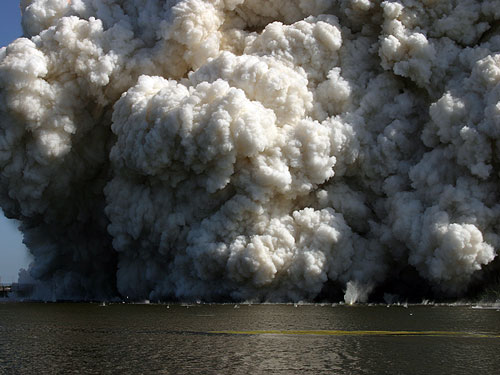 The source of that debris can be seen in photos of Pad 39A post-launch, as described by Bill Harwood for CBS: Launch pad 39A at the Kennedy Space Center suffered unusual damage during the shuttle Discovery's blastoff Saturday, NASA officials said Sunday.A photograph of the side of the pad directly behind the "flame trench" used to divert exhaust from the shuttle's solid-fuel boosters shows unidentified debris splashing into water behind the pad as Discovery climbed away. Pictures from a NASA source show buckled concrete and numerous concrete blocks or bricks, presumably from the flame trench, littering a road behind the pad. |
Mr Meek
Member Posts: 353
From: Chattanooga, TN
Registered: Dec 2007
|
 posted 06-02-2008 10:20 AM
posted 06-02-2008 10:20 AM
  
Well, 40 years, 12 Saturn V's, and 59 STS launches will take their toll. Is this the first time either of the pads at LC39 have suffered damage this dramatic? |
Jay Chladek
Member Posts: 2272
From: Bellevue, NE, USA
Registered: Aug 2007
|
 posted 06-02-2008 10:25 AM
posted 06-02-2008 10:25 AM
   
One thought that occurred to me watching this launch was the ascent of the shuttle off the pad seemed a little slower then on some previous launches, presumeably due to the heavy payload they were flying. There have been a few other heavy weight launches as well recently with the ISS flights. Part of me wonders if that might have been related to this problem. |
Robert Pearlman
Editor Posts: 42988
From: Houston, TX
Registered: Nov 1999
|
 posted 06-02-2008 10:37 AM
posted 06-02-2008 10:37 AM
   
quote:
Originally posted by Mr Meek:
Is this the first time either of the pads at LC39 have suffered damage this dramatic?
While damage this pronounced is not the norm, it is not (per my understanding) the first time it has occurred. If I had to guess however, I think you are right to suggest this damage is a factor of the pad's age rather than anything specific to this launch. Addendum: Looking back at my photographs taken of the pad during the first week of May, it appears that the buckled concrete was made worse by the launch, but was not caused by it. 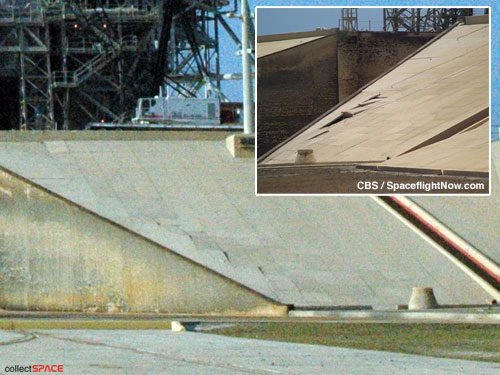 |
Mr Meek
Member Posts: 353
From: Chattanooga, TN
Registered: Dec 2007
|
 posted 06-02-2008 11:16 AM
posted 06-02-2008 11:16 AM
  
So, that means the United Space Alliance won't be sending CDR Mark Kelly a bill, then?  |
NavySpaceFan
Member Posts: 655
From: Norfolk, VA
Registered: May 2007
|
 posted 06-02-2008 11:48 AM
posted 06-02-2008 11:48 AM
   
quote:
Originally posted by Jay Chladek:
One thought that occurred to me watching this launch was the ascent of the shuttle off the pad seemed a little slower then on some previous launches, presumeably due to the heavy payload they were flying.
While KIBO is heavy, it does not have an effect on overall launch weight. Also, the Chandra X-Ray telescope was a heavier payload launched by a heavier orbiter (COLUMBIA). I concur with the age theory. |
Robert Pearlman
Editor Posts: 42988
From: Houston, TX
Registered: Nov 1999
|
 posted 06-02-2008 02:51 PM
posted 06-02-2008 02:51 PM
   
Kennedy Space Center has released a few more photographs:  During the post-launch walk down of Launch Pad 39A at NASA's Kennedy Space Center, the pad team noted severe launch damage on a 100' X 20' section of the east wall of the north flame trench (seen here). Broken sections of the flame trench wall were scattered from the flame trench to the pad perimeter fence. NASA is forming an investigation board. The flame trench transecting the pad's mound at ground level is 490 feet long, 58 feet wide and 40 feet high. It is made of concrete and refractory brick. The top of the solid rocket booster flame deflector abuts with that of the orbiter flame deflector to form a flattened, inverted V-shaped structure beneath the mobile launcher platform's three exhaust holes. The orbiter flame deflector is fixed and is 38 feet high, 72 feet long and 57.6 feet wide. The deflector weighs 1.3 million pounds. The solid rocket booster deflector is 42.5 feet high, 42 feet long and 57 feet wide. The structure weighs 1.1 million pounds. The deflectors are built of steel and covered with a high-temperature concrete surface with an average thickness of 5 inches. There are two movable solid rocket booster side flame deflectors, one located on each side of the flame trench. They are 19.5 feet high, 44 feet long and 17.5 feet wide. 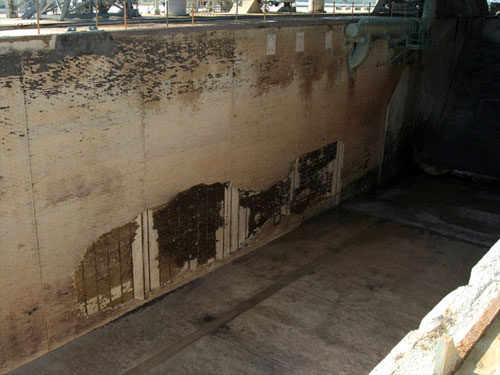 
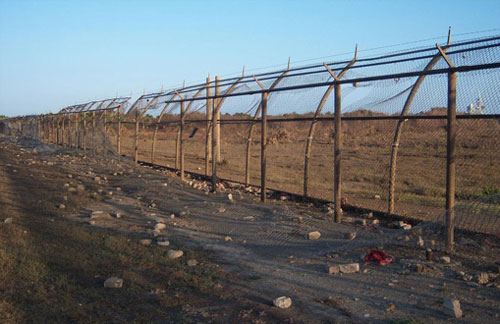
The damaged area of the flame trench is believed to date back to the original pad build, thus it survived 12 Saturn V and 69 space shuttle launches before STS-124. |
Jay Chladek
Member Posts: 2272
From: Bellevue, NE, USA
Registered: Aug 2007
|
 posted 06-02-2008 06:17 PM
posted 06-02-2008 06:17 PM
   
Wow, SRBs make pretty effective sand blasters (or should we say sonic blasters?) it seems. Looks like they got hit with a bit more acoustic energy then they should have.BTW, I would like to give a special shout out to the STS-124 crew and NASA for transmitting the downloaded imagery captured by the crew with full audio. I am currently watching the video they shot of the docking activities on the flight deck. Yesterday's highlights included video shot from flight day one from launch to on-orbit activities. It was a bit cute seeing the discussions between the crew when in the background you also happen to hear the fan for the shuttle's WCS spooling up as somebody on the mid-deck was getting ready to use it. It has been really cool to watch this coverage in realtime and highlighted without the dialog being muted. This more then anything makes you feel like you are onboard the orbiter as the eighth crewmember. Frankly, I hope NASA can do more coverage like this whenever possible (some crews tend to be more private then others and of course not everything can be shown as if it were an episode of "Big Brother") as it really helps people to comprehend what is going on during a mission. I haven't seen anything this good since the PBS show "Astronauts" where they had mission coverage of STS-72 in orbit. |
Mr Meek
Member Posts: 353
From: Chattanooga, TN
Registered: Dec 2007
|
 posted 06-03-2008 08:33 AM
posted 06-03-2008 08:33 AM
  
By the way, Robert, good LON question yesterday. Quite a contrast from the "Would you say you were lucky?" question and similarly toned follow-up by the other reporter who shall remain nameless.
|
Robert Pearlman
Editor Posts: 42988
From: Houston, TX
Registered: Nov 1999
|
 posted 06-03-2008 10:11 AM
posted 06-03-2008 10:11 AM
   
quote:
Originally posted by Mr Meek:
By the way, Robert, good LON question yesterday.
Thanks, though the answer really didn't offer any further details as to the structural stability of Pad 39A (or NASA's confidence in using a damaged pad). For those who missed the press conference, Cain's reply was simply that it was too early to know but fortunately, were a launch on need (LON) flight needed to support STS-124, they would have time to find the answer (and at this time, it doesn't appear as the LON capability will be needed). |
Robert Pearlman
Editor Posts: 42988
From: Houston, TX
Registered: Nov 1999
|
 posted 06-12-2008 05:25 PM
posted 06-12-2008 05:25 PM
   
New photographs released today by NASA: 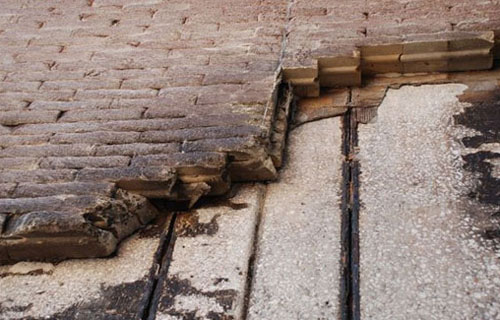 North Flame Trench - East View (Closeup) 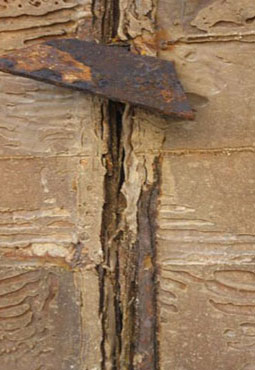
Metal Retention Clip 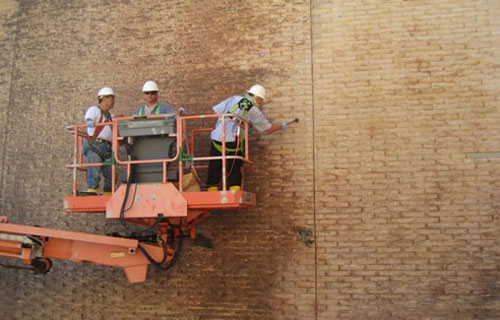
Flame Trench Sidewall Tap Testing |
Robert Pearlman
Editor Posts: 42988
From: Houston, TX
Registered: Nov 1999
|
 posted 06-12-2008 05:43 PM
posted 06-12-2008 05:43 PM
   
LeRoy Chain, mission management team chair, briefed the media this afternoon about the status of the investigation and repair effort. - NASA has high confidence that the repair can be completed with sufficient time as to not impact the targeted October 8, 2008 launch date for STS-125. "We don't have any issues relative to being able to do this work and be ready to launch the [Hubble Space Telescope] mission," said Cain.
- As Discovery launched on May 31, some 5,300 bricks on the northeast side of the flame trench were blown out, leaving bare concrete in an area roughly measuring 20 feet by 75 feet. While engineers later found signs of ricochets in the flame trench, video and still images show nothing came close to hitting the shuttle or even the underside of the mobile launch platform.
Cain said a re-assessment of the flame trench design confirmed there is virtually no chance for debris from inside the trench to ricochet or otherwise overcome the exhaust plume to strike the orbiter. An inspection of the mobile launch platform found no debris on its upper surface nor signs of impact or damage underneath. - Engineers discovered that the metal clips that help hold the bricks to the walls of the flame trench were severely rusted and corroded, probably due to decades of exposure to the acidic byproducts of booster exhaust. Inspectors also found areas where the absence of trowel marks indicates the epoxy intended to help hold the bricks to the underlying concrete wall was not uniformly applied. Subsequent "tap tests" have indicated voids behind 30 percent of the bricks that are still in place.
Engineers suspect similar problems may be lurking at pad 39B. Inspections and tap tests are ongoing. - Recommendations on the repair will be made to shuttle program manager John Shannon on June 26.
- The original brick vendor, A.P. Green, has inspected the pad, along with representatives of Atlantic Firebrick and Supply Co. Molds of the original bricks are still available but there is no existing stockpile. New bricks can be made, but not in time for the October launch.
"We have talked to the original vendor," Cain said. "The brick contracting company and the original vendor were on site to evaluate this issue for us. There apparently are no applications similar, or necessary, today and so they don't make this kind of brick. Whether or not it could be done, I don't know if we know the answer to that yet." - Another option under consideration, described by Cain as the leading candidate for a repair, would involve spraying the voids in the concrete with a thick coating of Fondu Fyre -- a heat-resistant Apollo-era material that is mixed with water, sprayed on and allowed to cure -- or a similar material.
"It's fair to say one of the options is looking at spraying the areas where we've lost brick," he said. "Possibly removing more brick and spraying would be a different option, or doing something other than spraying Fondu Fyre in the areas where we've lost brick to preserve those areas."
The above includes excerpts written by Bill Harwood, reprinted with his permission. |
Jay Chladek
Member Posts: 2272
From: Bellevue, NE, USA
Registered: Aug 2007
|
 posted 06-13-2008 12:46 AM
posted 06-13-2008 12:46 AM
   
Any idea what they plan to do with the original bricks that got blasted off the wall? Granted I figure getting a brick from Pad 39A to be an extreme long shot (it is neat to dream about having a piece of history that has withstood launches dating all the way back to Apollo 4), but it would be interesting to see what NASA plans to do with them when the investigation is fully concluded.Of course they've probably absorbed so many acidic byproducts from the SRB exhasuts of 60 plus launches that they are probably considered too toxic for collectability anyway. |
Robert Pearlman
Editor Posts: 42988
From: Houston, TX
Registered: Nov 1999
|
 posted 06-13-2008 08:26 AM
posted 06-13-2008 08:26 AM
   
Given they had to send an asbestos clean-up crew in before even the inspectors could take a look at the damage, I suspect that most of the material, for that reason and those that you outline, will be cleaned up and disposed of as if it was hazardous. That said, should they decide that the repair includes stripping the entire flame trench of its original bricks, I can imagine you won't be the only person asking about the fate of the material...
|
divemaster
Member Posts: 1376
From: ridgefield, ct
Registered: May 2002
|
 posted 06-17-2008 01:47 PM
posted 06-17-2008 01:47 PM
   
Great photo of the entire flame trench. I was looking at the relationship between the flame deflector, the pad and the walls and was surprised when I realized that all of the flame is deflected in teh same direction. I thought that the SRB exhaust went one way and the SSME's were vented in the opposite direction. You learn something new every day. And to my untrained eyes, it sure looks like the wall damage appeared to be a ripple or tearing effect from underneath the right SRB. 45 years of wear and tear and exposure to salt air, I'm sure. Great photo, though. |
Ben
Member Posts: 1896
From: Cape Canaveral, FL
Registered: May 2000
|
 posted 06-17-2008 02:35 PM
posted 06-17-2008 02:35 PM
   
quote:
Originally posted by divemaster:
and was surprised when I realized that all of the flame is deflected in teh same direction. I thought that the SRB exhaust went one way and the SSME's were vented in the opposite direction.
No, they do. It is just an illusion in that photo. The SSME opening is on the other side of the wall; there is a deflector facing on that side as well.
|
divemaster
Member Posts: 1376
From: ridgefield, ct
Registered: May 2002
|
 posted 06-17-2008 04:29 PM
posted 06-17-2008 04:29 PM
   
An optical illusion!!! I'm not as dumb as I look!But, obviously, I'm fooled easily. Still an incredible photo. |
Jay Chladek
Member Posts: 2272
From: Bellevue, NE, USA
Registered: Aug 2007
|
 posted 06-18-2008 11:32 AM
posted 06-18-2008 11:32 AM
   
SSME flames are deflected out under the tail of the orbiter (to the south) through the center flame trench. The SRB flames are actually deflected to the south and north sides of the pad through their flame trenches. You can see it rather well on replays of launches taken from the cameras placed directly to the side of the shuttle stack. |
Robert Pearlman
Editor Posts: 42988
From: Houston, TX
Registered: Nov 1999
|
 posted 06-26-2008 05:17 PM
posted 06-26-2008 05:17 PM
   
NASA today announced its plan to repair Pad 39A, as well as how they believe the damage was caused, reports Bill Harwood for CBS/Spaceflight Now: "We did find evidence of a fracture joint along a construction joint between the first and second panels of the east wall," said Perry Becker, chief of NASA's structural systems branch at the Kennedy Space Center. "We believe that fracture was brought on by a number of different components. We have found erosion of some anchor plates that were used to secure the brick to the back wall. We've found degradation of the epoxy that was used to adhere the brick to the back wall. We have found evidence of acid deposition in that area. We've found evidence of carbonation in the area, which leeches the calcium out of the concrete, which reduces the strength of the mortar-to-concrete joints."Becker said the damage that occurred during Discovery's May 31 liftoff apparently happened when a Fondu Fyre patch over an area of earlier erosion ripped away seconds after booster ignition. "We believe, based on pre- and post-launch pictures, that we liberated a Fondu Fyre patch that was put over an area of fairly significant erosion," he said. "We think the lack of adhesion on that wall resulted in some bowing off the back wall and resulted in the liberation of that patch. Once that patch was liberated at launch, we believe that created the intrusion point that got the hot gas behind the wall." Once booster exhaust gases got behind the brick layer, "we had impingement on the back wall and with no real adhesive strength left in that local area, we started a localized failure," Becker said. "Due to the interlocking nature of the brick, we believe that led to a cascading failure on down the wall." To fix the trench, writes Harwood, a 25-by-100-foot section of the east wall of the trench will be stripped of bricks, as will a 25-by-80-foot section of the west wall. A steel mesh-like structure will be erected over the exposed backwall and then covered in sprayed-on Fondu Fyre, a material already used to protect the massive flame deflector directly under the shuttle's boosters and main engines.Working two 10-hour shifts per day, the repair team expects to have the brick removed by July 19. After that, the mesh will be erected and the Fondue Fyre applied. Space shuttle processing manager Rita Willcoxon said the repair should be complete by the third week in August. |
Robert Pearlman
Editor Posts: 42988
From: Houston, TX
Registered: Nov 1999
|
 posted 06-27-2008 11:21 AM
posted 06-27-2008 11:21 AM
   
Discovery Channel approached me earlier this week about writing an editorial about what I felt should happen to the flame trench bricks.If These Walls Could Talk, They'd Say 'Save Me!' The scoop: The scorched bricks beneath Launch Pad 39A at Kennedy Space Center have witnessed decades of spaceflight history. But after a recent space shuttle launch blew thousands of them from the pad, NASA intends to throw these pieces of history away. 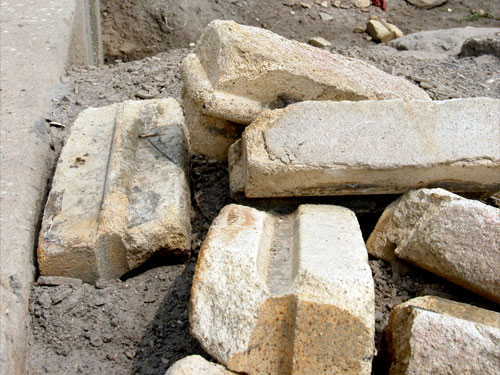 |
Jay Chladek
Member Posts: 2272
From: Bellevue, NE, USA
Registered: Aug 2007
|
 posted 06-27-2008 01:54 PM
posted 06-27-2008 01:54 PM
   
Very well written editorial Robert. Maybe it will get some people to think about the fate of the bricks. If those walls could talk indeed. |
MrSpace86
Member Posts: 1618
From: Gardner, KS, USA
Registered: Feb 2003
|
 posted 06-27-2008 02:43 PM
posted 06-27-2008 02:43 PM
   
They should be saved and turned into launch complex fragments, similar to the ones they sell at the Air Force Station.For a $1 donation, you could own a piece of Pad 39A... Just a crazy thought.  |
mjanovec
Member Posts: 3811
From: Midwest, USA
Registered: Jul 2005
|
 posted 06-27-2008 06:40 PM
posted 06-27-2008 06:40 PM
   
quote:
Originally posted by MrSpace86:
They should be saved and turned into launch complex fragments, similar to the ones they sell at the Air Force Station.
It seems rather doubtful that NASA would make these bricks available to the public and risk any liability associated with distributing toxic material (even if the toxicity of the bricks is probably minor). I think the best we can probably hope for is that some of these bricks are sent to museums that can properly display them. |
Jay Chladek
Member Posts: 2272
From: Bellevue, NE, USA
Registered: Aug 2007
|
 posted 06-28-2008 01:43 AM
posted 06-28-2008 01:43 AM
   
Well they have done it with the tiles. My local museum has three or four shuttle tiles on display from Columbia's first flights as part of a loan from the Smithsonian. |
Hawkman
Member Posts: 400
From: Union, New Jersey
Registered: Jan 2001
|
 posted 06-28-2008 03:53 PM
posted 06-28-2008 03:53 PM
   
Robert's excellent editorial says this..."Given NASA's precedent, I think the agency should take that additional step to find a company to embed the historic bricks safely in acrylic and make them available to museums, educational institutions, NASA employees and perhaps even the public." Before I even read the article, this was my first thought! I only hope that NASA does take the steps to preserve the bricks, or pieces thereof, in acrylic and sell them to the public perhaps to defray the cost of fixing the trench. Who do I call?  |
Robert Pearlman
Editor Posts: 42988
From: Houston, TX
Registered: Nov 1999
|
 posted 06-29-2008 10:10 AM
posted 06-29-2008 10:10 AM
   
NASA Watch has linked to the editorial on Discovery's website and has elicited a number of comments in support of what I proposed... |
Hawkman
Member Posts: 400
From: Union, New Jersey
Registered: Jan 2001
|
 posted 06-29-2008 04:09 PM
posted 06-29-2008 04:09 PM
   
So we aren't the only ones thinking about it. Good. If we could keep the momentum going, it might just happen.
|
AFGAS
Member Posts: 89
From: Merritt Island, FL
Registered: Feb 2008
|
 posted 06-30-2008 07:07 AM
posted 06-30-2008 07:07 AM
   
So, these bricks will be treated and disposed of because they contain asbestos. Asbestos is considered toxic when fibers are inhaled during daily work, leading to tumors and mesothelioma. Again, to be toxic, fibers must be inhaled regularly over a period of time. Although fibers are found naturally in the environment, the only time fibers of this sort are present are during manufacturing and removal projects. A brick containing asbestos could only hurt you if it fell on your head. For asbestos to be a concern, you would first have to pulverize it into particles that would remain airborne and then breath that dust for a length of time. The odds are that a brick owner would develop mesothelioma, and although it may take 20 to 50 years for symptoms to develop after exposure, would sue the government. So sad. |
Hawkman
Member Posts: 400
From: Union, New Jersey
Registered: Jan 2001
|
 posted 06-30-2008 03:11 PM
posted 06-30-2008 03:11 PM
   
quote:
Originally posted by AFGAS:
The odds are that a brick owner would develop mesothelioma, and although it may take 20 to 50 years for symptoms to develop after exposure, would sue the government.
What are the odds if the brick is encased in lucite?  |
tegwilym
Member Posts: 2331
From: Sturgeon Bay, WI
Registered: Jan 2000
|
 posted 06-30-2008 03:38 PM
posted 06-30-2008 03:38 PM
   
Something that was blasted a few times by Saturn V F-1 engines and many SRBs? I'd buy a chunk! |
AFGAS
Member Posts: 89
From: Merritt Island, FL
Registered: Feb 2008
|
 posted 06-30-2008 06:05 PM
posted 06-30-2008 06:05 PM
   
quote:
Originally posted by Hawkman:
What are the odds if the brick is encased in lucite?
Great question! And the point I'm trying to make is that even encased in lucite, one of the many owners of a brick would develop mesothelioma - they would have without having the brick. The brick would not be cause, and could not be the cause, but since when would facts prevent a lawsuit from occurring? |
Robert Pearlman
Editor Posts: 42988
From: Houston, TX
Registered: Nov 1999
|
 posted 07-04-2008 02:54 PM
posted 07-04-2008 02:54 PM
   
Since writing the editorial for Discovery, I have learned that NASA's Exhibits Program is now looking into saving at least some of the flame trench bricks. I'll share updates as I learn them.I have also been forwarded the following photographs documenting the progress within the trench and have been promised additional, more detailed imagery. Click on photos to enlarge. 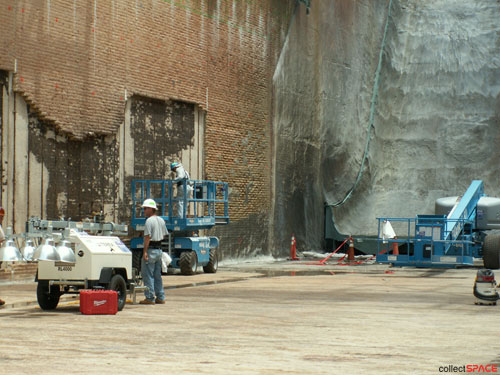 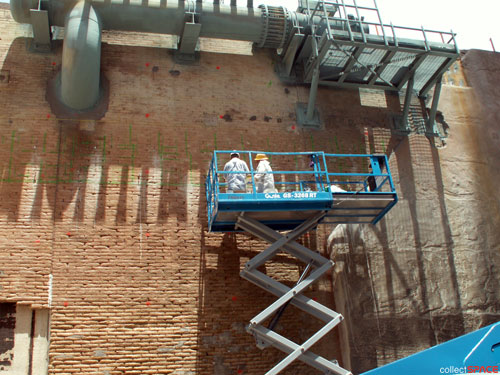
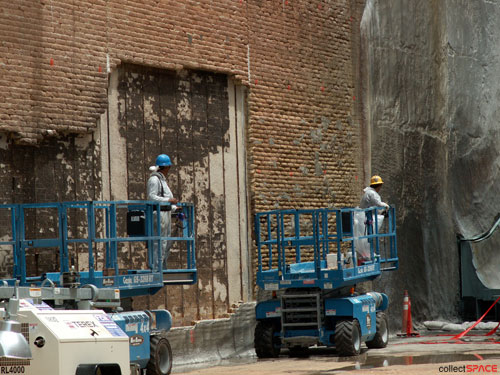
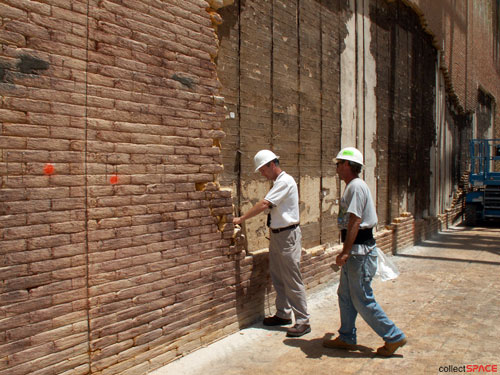
|
Robert Pearlman
Editor Posts: 42988
From: Houston, TX
Registered: Nov 1999
|
 posted 07-06-2008 12:05 PM
posted 07-06-2008 12:05 PM
   
The work in the flame trench has now been proceeding 24 hours a day for a week. These pictures, taken on July 4, show the progress made thus far. The metal squares that you see are keeper plates. Below them, is a slice of 3/4" thick steel angle, held in place with Hilti anchors. Click on photos to enlarge.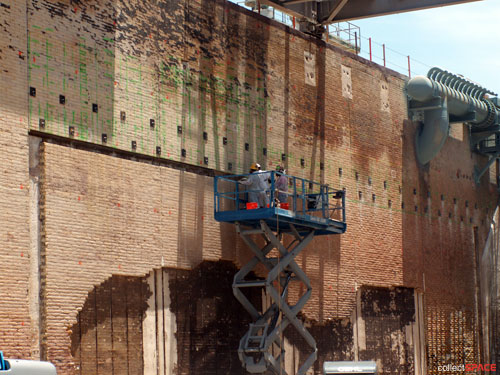 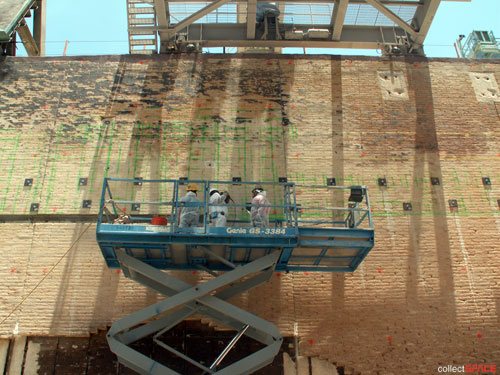
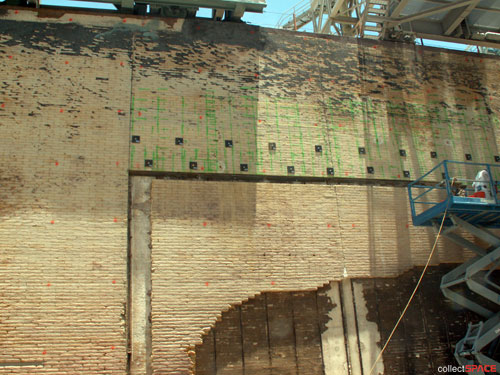
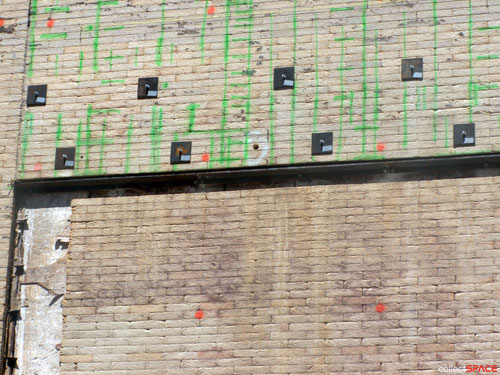
|
onesmallstep
Member Posts: 1310
From: Staten Island, New York USA
Registered: Nov 2007
|
 posted 07-07-2008 11:25 AM
posted 07-07-2008 11:25 AM
   
While 'saving' these bricks is all well and good (especially for the collectors out there), why not a more permanent and fitting resting place for them: as part of the walkway/pavement leading from the astronaut crew quarters at KSC to the astrovan? It would be akin to the original brick roadbed preserved at the Indy 500 motor speedway-another 'brickyard', this time for the space age...  |
Robert Pearlman
Editor Posts: 42988
From: Houston, TX
Registered: Nov 1999
|
 posted 07-07-2008 11:34 AM
posted 07-07-2008 11:34 AM
   
I am told that the ejected and removed bricks are highly brittle, such that even moving them can result in their breaking into pieces. As such, walking or driving on them might result in a very short lived roadbed. Otherwise, a fine idea, which would have also been appropriate for the walkway near the U.S. Space Walk of Fame Foundation's new monument to Project Apollo. |
Mark Ancona
New Member Posts: 1
From: Cocoa, Florida USA
Registered: Jul 2008
|
 posted 07-12-2008 11:27 AM
posted 07-12-2008 11:27 AM
  
The folks on the scissor lifts [in the previous pics] are my employees. We have been working around the clock for over two weeks to complete the first three phases of this project. NASA lit a class three bonfire under someone's ass on this one, because I have NEVER seen this many engineers tasked with the resolution of a single issue... EVER! At one point, we had 9 employees in the trench and there were 21 engineers, USA and SGS staffers in attendance. We are now in the process of hydroblasting the surfaces with 40,000 psi filtered water. This procedure creates a very rough surface on the concrete, allowing a better purchase for the fondue fyre refractory cement. If you are watching at the Florida Today's Flame Trench blog Pad 39 cam, you will see that we have completed a significant quantity of work in these 16 short days. I will send Robert more pictures later today or early tomorrow. I'll be out at the pad Sunday morning to take some final shots. |
Robert Pearlman
Editor Posts: 42988
From: Houston, TX
Registered: Nov 1999
|
 posted 07-12-2008 09:08 PM
posted 07-12-2008 09:08 PM
   
Click on photos to enlarge.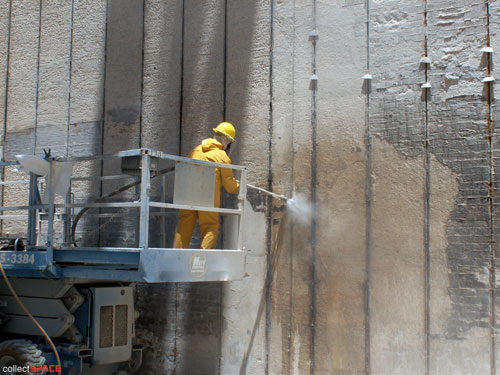 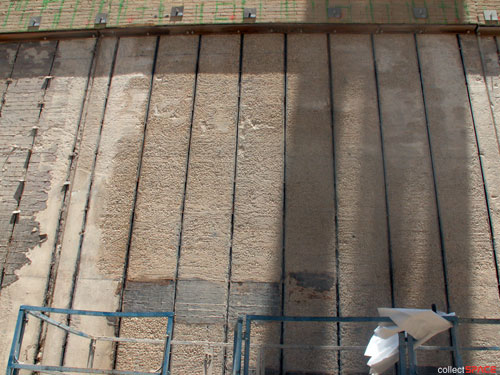
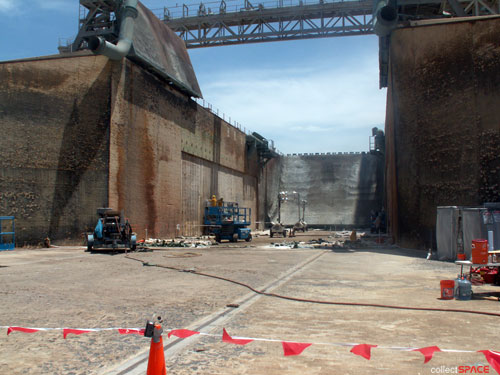
NASA has also added new photographs of the flame trench to its KSC Media Archive. And SPACE.com has additional video showing the aftermath of the backhoe's work. |
Robert Pearlman
Editor Posts: 42988
From: Houston, TX
Registered: Nov 1999
|
 posted 07-22-2008 11:23 PM
posted 07-22-2008 11:23 PM
   
As noted by NASASpaceflight.com, the flame trench repair has moved into its second phase, the application of Fondu Fyre, a heat-resistant Apollo-era material that is mixed with water, sprayed on and allowed to cure.Before that could happen however, anchors and plates were installed, as illustrated by the following photographs. 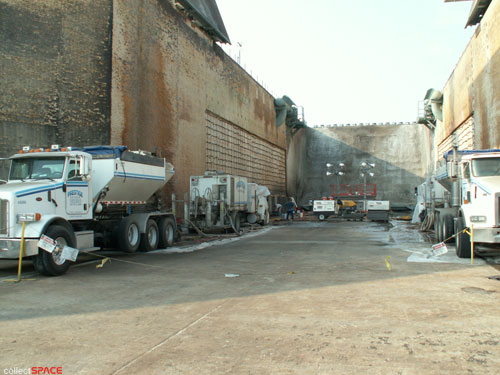 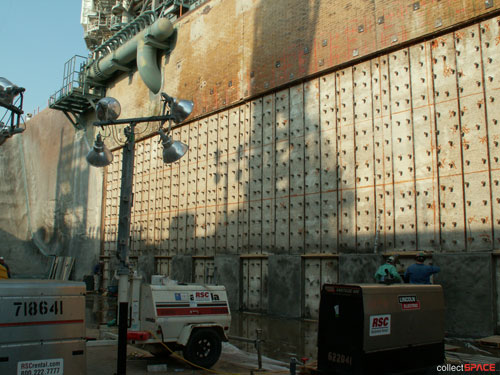
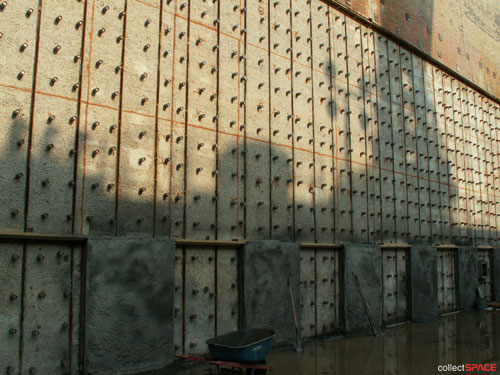
|
Robert Pearlman
Editor Posts: 42988
From: Houston, TX
Registered: Nov 1999
|
 posted 07-22-2008 11:24 PM
posted 07-22-2008 11:24 PM
   
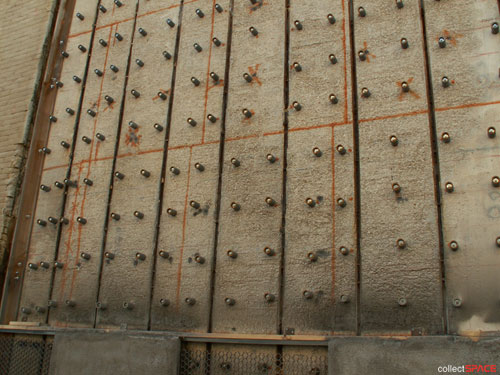 Notice the big pegs? These are nothing more than pipe segments with a plug welded to them. A hole is drilled through the top to permit a threaded rod to pass through. The wire fabric is welded to the tops of these pegs. It is difficult to see, but there is a keyway being formed into three sides of these fondu fyre panels being sprayed in place. This is to ensure that the panels have some measure of independence from one another, while at the same time affording a measure of integrated lateral support. 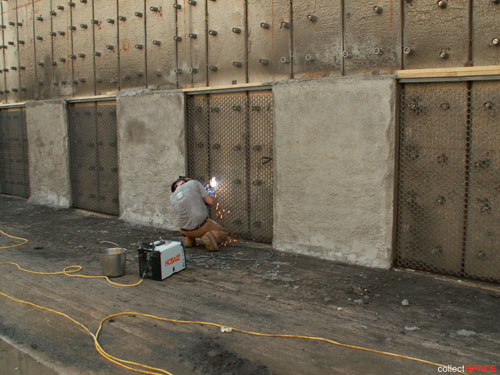 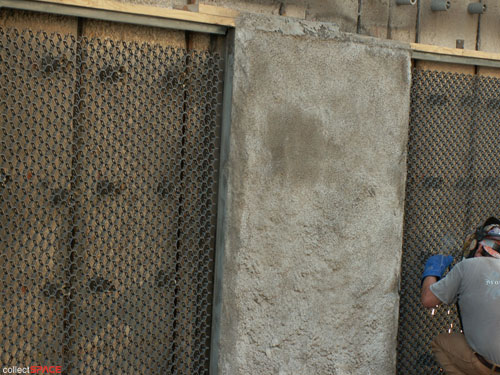
|









































